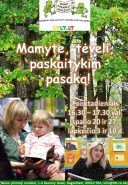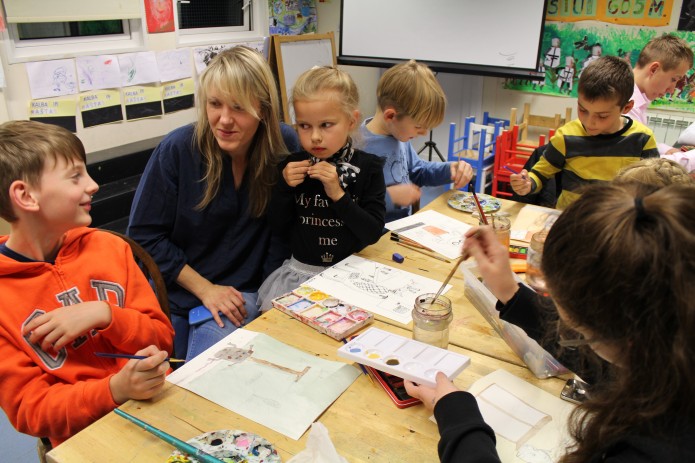Our teacher Alma about art, art therapy and benefits of holistic education
- Category: News
- Date: May 1, 2016
To mark the occasion of Leaping Toads celebrating its 8th Anniversary, we are launching a newsletter and a series of interviews with our teachers, who are not only experts in their professional field but who also share their professional knowledge, experience and skills with younger generations.
For the first of our interviews we talk to Leaping Toads’ Art and Primary teacher, Alma Sleckute about holistic education, art, and children’s self development based on art therapy methods.
Alma has worked at Leaping Toads for eight years. Alma has a bachelor’s degree in Educology, Primary School and Art teaching from the Pedagogy Faculty (Sauliai University, Lithuania) and attended the School of Fine Arts. She has lived in the UK since 2003 and has two children of her own.
Together with Simona Staputiene (Leaping Toad’s Principal and founder), Alma has developed Leaping Toads’ pre-school curriculum and a wide range of educational materials and actively contributes to its continual improvement.
Alma, what does holistic education mean to you and why did you choose to work at Leaping Toads holistic school?
The holistic education which I now teach at Leaping Toads is far different to the traditional education system which I experienced in my youth, where some subjects seemed to have no connection with real life. Fortunately several illuminating teachers enabled and encouraged me to analyse some areas deeper, to work out my own thoughts and curiosities, to maintain my interest and develop an understanding.
Holistic education is a ‘live’ education, which is constantly evolving and covering many areas, based on discovery, playing, creating and exploring, rather than learning from text-books.
For example, a variety of subjects (science, music, dance, mathematics and art) are all creatively integrated into language lessons.
This enables children to explore themselves, develop many capabilities simultaneously, memorise information much easier, and to apply their new-found knowledge and skills to real-life situations.
It is a very rewarding experience all round and I’m proud that our pupils’ achievements at Leaping Toads are recorded to be higher than indicated in the General Regulations – and to me that is reflective of the fact that holistic education is effective.
I firmly believe that to work in such a holistic environment you need to be very creative, flexible, and seeking to constantly improve. Children come from various backgrounds and possess different knowledge and skills so our task is to help and inspire each and every child and highlight their strengths. At this school, I too can realise and carry out my own development, which gives me much satisfaction.
How would you define a teacher …….. a school …. a pupil ?
To me, a ‘teacher’ is not necessarily just the person with qualifications – I feel that teaching is a vocation, a calling and that many people have the capability and desire to impart knowledge and share it with others.
I see our school as a whole community made up of three parts – pupils, their parents and teachers.
And a pupil, I believe is the most important member of this small community
When and why did you become interested in art?
The question should be “when did you start drawing?”
My first drawings appeared in my storybooks and on the chessboard, outside of school time.
My mum was interested in art and introduced me to eminent art works and artists, even though she wasn’t an artist herself.
Later, at the School of Fine Arts and at university I learned more techniques of art performance as well as certain rules. This led to a deeper interest in art and independent explorations of more fields which I was interested in. I am glad that I can transfer my experience to my students.
How did you become interested in art therapy?
The way art and colours influence a person has always greatly interested me.
I believe that a spontaneous drawing can say much about a person’s emotions and feelings. I always wanted to combine art and psychology to primarily help myself and then be able to help others to read their own feelings which I now do.
Art therapy in particular is based on the creative process of visual art and the synthesis of psychology and psychotherapy. So the choice of interest in art therapy came naturally.
How do you explain art therapy?
In art therapy drawing, painting, and molding act as a means to express one’s feelings, emotions and experiences. While drawing, a person can relax, awaken their memories and may use a range of colours to say what words cannot express. It is a way for a person to “splash” all of their emotions, which have been contained inside of them, onto a sheet of paper. Discussion and analysis are very important in this process. This allows the person to better understand their own nature and feelings better and come up with solutions. People attend art therapy sessions not to become great painters or artists but to become more integrated and creative members of society.
What is the best age for children to start art therapy and why?
It is best to start when children are around 4 to 6 years old, as they are conscious of their thoughts, and it is possible to discuss their works as well as the emotions and feelings they have experienced in the process.
Is it suitable for adults?
Yes, certainly!
What do pupils do when they come to art therapy classes?
At the moment, Leaping Toads is running a 12-24 hour course on The Development of a Socially Responsible Personality using techniques of art therapy.
Pupils draw, paint or mold on the spot and go through many emotions and experiences. In these classes pupils learn to organise themselves, focus, and follow the rules.
During the discussions of their works, pupils are encouraged to listen to what others have to say and respect a friend, also, express their own opinion and describe feelings.
What are the outcomes of art therapy sessions?
During the classes children gain confidence and release their creativity.
They become more empathetic and it is easier for them to focus at school. In the art therapy workshop they experience a lot of positive emotions, which in turn promotes positive thinking.
By developing emotional intelligence and going deeper into themselves (program of self-awareness), children learn how to assess themselves, their capabilities, make responsible decisions, formulate and refine their goals, understand their emotions, and release negative emotions in a socially acceptable manner.
Do you use art therapy techniques during other classes?
I use art therapy techniques on demand, regardless of the subject taught. They are indispensable when children need to concentrate, relax or calm down. I think a teacher must use a variety of methods in order to create the right atmosphere in lessons and to achieve the expected results. Personally, I believe art therapy techniques are among the most effective. However, each teacher is unique and chooses different methods to best suit their students and their own approach.
Leaping Toads lessons run by Alma take place on:
Art: Tuesdays, Thursdays and Fridays from 4.30 to 6.30 pm
Art Therapy: Saturdays from 2.30pm to 4.30 pm
For more information and to register your child for a complimentary art or art therapy session please email info@ltlt.co.uk
Video presentation sources:
- Socially Responsible Personality Development program I am a Creator by Marija Mendele – Leliugiene.
- Marija Mendele-Leliugiene , “Socialiai atsakingos asmenybės ugdymo modelis” (Socially Responsible Personality Development Model), (2012), Vilnius, LT: Justitia, p. 67.









